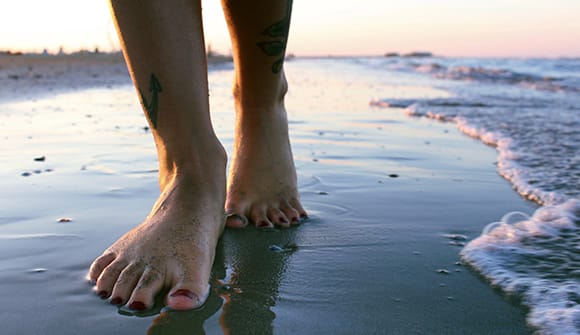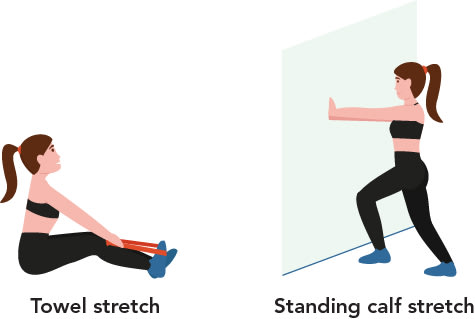Healing heel pain
Remedies to recover from plantar fasciitis.
Article Author: Beth Stambaugh
Article Date:

It’s hard to “hit the ground running” if you feel stabbing heel pain as soon as your feet touch the floor. What’s happening?
The most common cause of heel pain is plantar fasciitis, a condition that more than 3 million people in the United States suffer from each year.
“Sharp heel pain that is more pronounced when you first get on your feet is the classic symptom,” said Turner Vosseller, MD, an orthopedic foot and ankle surgeon with Jacksonville Orthopaedic Institute (JOI).
Plantar fasciitis occurs when the thick band of tissues connecting the heel bone to the toes (called the plantar fascia) develops small tears.
“It’s a deterioration, or failed healing response, of the plantar fascia related to tightness in the calf muscle,” explained Dr. Vosseller. “The pain is frequently worse in the morning and gets better with activity. However, when you get off your feet for a period of time and then get back on them, the discomfort often returns.”
Simple stretches
While ice and over-the-counter anti-inflammatories may help mask the pain, stretching and physical therapy can help treat the underlying problem.
Here are some basic calf stretches that can help:

Towel stretch: In a sitting position with your legs straight in front of you, take a towel and wrap it around the bottom of your foot. Gently pull the towel toward you, stretching the calf, and avoid bending your knee.
Standing calf stretch: Stand facing a wall with your hands on the wall at eye level. Put your affected foot a step behind your other leg. Keeping both heels on the floor, and the knee of the affected side fully extended or straight, push against the wall as if you were trying to push it away. You should feel a stretch in your upper calf. Hold the stretch for a full minute and do it three times a day.
“It’s important to get on a regular stretching routine,” said Dr. Vosseller. “It can be frustrating at first because it takes some time for the stretching to work. Results will start to show up typically after stretching consistently for two to four weeks.”
Even if you aren’t having symptoms, stretching before and after exercise can help prevent plantar fasciitis.
Alternative treatment techniques
While steroid injections have historically been used for plantar fasciitis, Dr. Vosseller has seen success with other options.
“I will often try a technique that I have termed ‘wet needling’ first,” said Dr. Vosseller. “This involves inserting needles into the affected area while injecting local anesthetic, which can help promote the healing process.”
For some patients, he injects platelet-rich plasma (PRP) or bone marrow aspirate (BMA), both of which are harvested from the patient and then injected into the bottom of the foot. “While needling can initiate a healing response, injecting PRP or BMA sometimes helps patients experience more robust healing,” he said.
Surgery is usually a last resort, with only about 3% of Dr. Vosseller’s patients requiring it after noninvasive treatments have been exhausted. “People with chronic plantar fasciitis – lasting 6 to 9 months or longer – may be good candidates for surgery, especially if they have occupations that require them to be on their feet all day,” said Dr. Vosseller.
Don’t wait
Ignoring plantar fasciitis can lead to chronic heel pain that prevents you from enjoying your regular activities. Compensating for it by changing the way you walk can lead to foot, knee, hip or back problems.
If you’re experiencing sharp heel pain that’s preventing you from doing your normal activities, JOI has skilled orthopedic physicians who can help. Call JOI.2000 or go to joionline.net to make an appointment.



